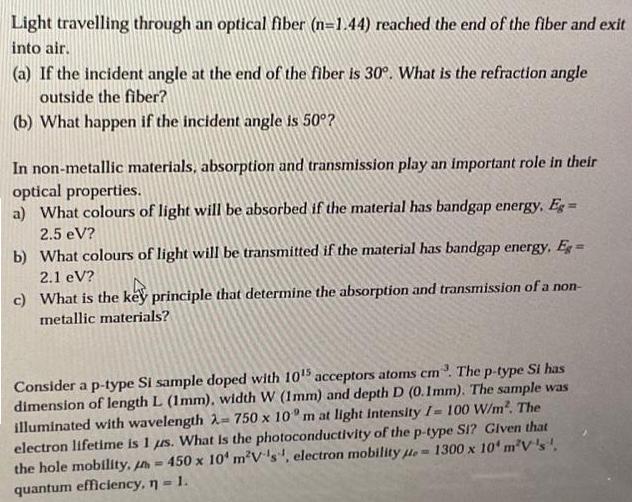Answered step by step
Verified Expert Solution
Question
1 Approved Answer
Light travelling through an optical fiber (n=1.44) reached the end of the fiber and exit into air. (a) If the incident angle at the

Light travelling through an optical fiber (n=1.44) reached the end of the fiber and exit into air. (a) If the incident angle at the end of the fiber is 30. What is the refraction angle outside the fiber? (b) What happen if the incident angle is 50? In non-metallic materials, absorption and transmission play an important role in their optical properties. a) What colours of light will be absorbed if the material has bandgap energy, Eg= 2.5 eV? b) What colours of light will be transmitted if the material has bandgap energy, Eg= 2.1 eV? c) What is the key principle that determine the absorption and transmission of a non- metallic materials? Consider a p-type Si sample doped with 105 acceptors atoms cm. The p-type Si has dimension of length L (1mm), width W (1mm) and depth D (0.1mm). The sample was illuminated with wavelength 2- 750 x 10 m at light intensity I= 100 W/m. The electron lifetime is 1 us. What is the photoconductivity of the p-type Si? Given that the hole mobility. = 450 x 10 mV's, electron mobility = 1300 x 10' m'V's'. quantum efficiency, n = 1.
Step by Step Solution
★★★★★
3.46 Rating (162 Votes )
There are 3 Steps involved in it
Step: 1
Light in Optical Fiber and Material Interaction 1 Light in Optical Fiber a Refraction Angle Use Snells Law n1 sin1 n2 sin2 Where n1 Refractive index o...
Get Instant Access to Expert-Tailored Solutions
See step-by-step solutions with expert insights and AI powered tools for academic success
Step: 2

Step: 3

Ace Your Homework with AI
Get the answers you need in no time with our AI-driven, step-by-step assistance
Get Started


